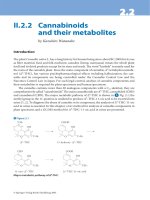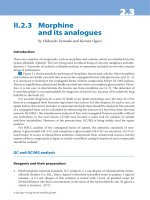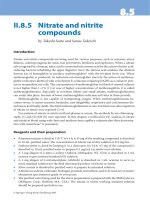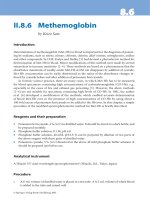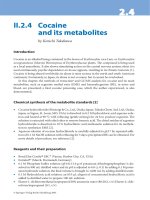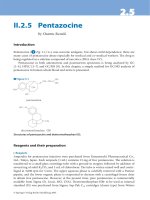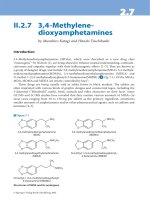Handbook of water analysis, third edition
Bạn đang xem bản rút gọn của tài liệu. Xem và tải ngay bản đầy đủ của tài liệu tại đây (37.31 MB, 966 trang )
Tai Lieu Chat Luong
THIRD EDITION
© 2014 by Taylor & Francis Group, LLC
© 2014 by Taylor & Francis Group, LLC
THIRD EDITION
EDITED BY
Leo M. L. Nollet
L e e n S . P. D e G e l d e r
Boca Raton London New York
CRC Press is an imprint of the
Taylor & Francis Group, an informa business
© 2014 by Taylor & Francis Group, LLC
CRC Press
Taylor & Francis Group
6000 Broken Sound Parkway NW, Suite 300
Boca Raton, FL 33487-2742
© 2014 by Taylor & Francis Group, LLC
CRC Press is an imprint of Taylor & Francis Group, an Informa business
No claim to original U.S. Government works
Version Date: 20130614
International Standard Book Number-13: 978-1-4398-8966-4 (eBook - PDF)
This book contains information obtained from authentic and highly regarded sources. Reasonable efforts have been
made to publish reliable data and information, but the author and publisher cannot assume responsibility for the validity of all materials or the consequences of their use. The authors and publishers have attempted to trace the copyright
holders of all material reproduced in this publication and apologize to copyright holders if permission to publish in this
form has not been obtained. If any copyright material has not been acknowledged please write and let us know so we may
rectify in any future reprint.
Except as permitted under U.S. Copyright Law, no part of this book may be reprinted, reproduced, transmitted, or utilized in any form by any electronic, mechanical, or other means, now known or hereafter invented, including photocopying, microfilming, and recording, or in any information storage or retrieval system, without written permission from the
publishers.
For permission to photocopy or use material electronically from this work, please access www.copyright.com (http://
www.copyright.com/) or contact the Copyright Clearance Center, Inc. (CCC), 222 Rosewood Drive, Danvers, MA 01923,
978-750-8400. CCC is a not-for-profit organization that provides licenses and registration for a variety of users. For
organizations that have been granted a photocopy license by the CCC, a separate system of payment has been arranged.
Trademark Notice: Product or corporate names may be trademarks or registered trademarks, and are used only for
identification and explanation without intent to infringe.
Visit the Taylor & Francis Web site at
and the CRC Press Web site at
Contents
Preface....................................................................................................................................................... ix
Editors........................................................................................................................................................ xi
Contributors.............................................................................................................................................xiii
Section I Sampling and Data Treatment Methods
1. Sampling Methods in Surface Waters............................................................................................. 3
Munro Mortimer, Jochen F. Müller, and Matthias Liess
2. Methods of Treatment of Data....................................................................................................... 47
Riccardo Leardi
Section II Radioanalytical Analysis
3. Radioanalytical Methodology for Water Analysis....................................................................... 79
Jorge S. Alvarado
Section III Organoleptical Analysis
4. Organoleptical Methodology.........................................................................................................101
Abdul Moheman, Md. Musawwer Khan, and K. S. Siddiqi
Section IV Analysis of Biological Parameters
5. Bacteriological Analysis of Water.................................................................................................115
Paulinus Chigbu and Salina Parveen
6. Marine Toxins Analysis.................................................................................................................153
Luis M. Botana, A. Alfonso, M. R. Vieytes, N. Vilariño, A. M. Botana, C. Louzao,
and C. Vale
7. Algal Analysis.................................................................................................................................163
Leonardo Rubi Rörig
Section V Halogens, N-Compounds, and Phosphates
8. Halogens..........................................................................................................................................189
Géza Nagy and Livia Nagy
9. Analysis of Sulfur Compounds in Water.................................................................................... 233
Leo M. L. Nollet
v
© 2014 by Taylor & Francis Group, LLC
vi
Contents
10. Determination of Ammonia in Water Samples.......................................................................... 249
Juliana Antunes Galvão, Alexandre Matthiensen, Marília Oetterer, Y. Moliner-Martínez,
R. A. Gonzalez-Fuenzalida, M. Moz-Orto, R. Herráez-Hernández, J. Verdú-Andrés,
C. Molins-Legua, and P. Campíns Falcó
11. Nitrites and Nitrates...................................................................................................................... 283
Adnan Aydın
12. Phosphates in Aquatic Systems.................................................................................................... 327
Alexandre Matthiensen, Juliana Antunes Galvão, and Marília Oetterer
Section VI Cyanides, Asbestos, Metals, and Si-Compounds
13. Cyanides......................................................................................................................................... 365
Leo M. L. Nollet
14. Asbestos in Water.......................................................................................................................... 379
James S. Webber
15. Heavy Metals, Major Metals, Trace Elements........................................................................... 385
Jorge E. Marcovecchio, Sandra E. Botté, Claudia E. Domini, and Rubén H. Freije
16. Determination of Silicon and Silicates.........................................................................................435
Salah M. Sultan
Section VII Organic Parameters
17. Main Parameters and Assays Involved with the Organic Pollution of Water........................ 459
Lorena Vidal, Claudia E. Domini, and Antonio Canals
18. Determination of Organic Nitrogen in the Aquatic Environment........................................... 493
Juliana Antunes Galvão, Alexandre Matthiensen, and Marília Oetterer
19. Determination of Urea in Aquatic Samples.................................................................................511
Juliana Antunes Galvão, Alexandre Matthiensen, and Marília Oetterer
20. Organic Acids.................................................................................................................................521
Mercedes Gallego Fernández, Evaristo Ballesteros Tribaldo, and Beatriz Jurado Sánchez
21. Determination of Volatile Organic Compounds in Water........................................................ 549
Iván P. Román Falcó and Marta Nogueroles Moya
Section VIII Phenolic and Humic Compounds
22. Determination of Phenolic Compounds in Water.......................................................................613
Leo M. L. Nollet
23. Characterization of Humic Matter.............................................................................................. 647
Leo M. L. Nollet
© 2014 by Taylor & Francis Group, LLC
Contents
vii
Section IX Residues of Pesticides
24. Determination of Pesticides in Water.......................................................................................... 665
Evaristo Ballesteros Tribaldo
25. Analysis of Herbicide and Fungicide Residues in Waters......................................................... 697
N. Sridhara Chary, Maria Jose Gómez Ramos, and Amadeo R. Fernández-Alba
Section X Residues of PCBs, PCDDs, PCDFS, and PAHs
26. Analysis of PCBs in Waters.......................................................................................................... 765
L. Bartolomé, O. Zuloaga, and N. Etxebarria
27. PCDDs and PCDFs....................................................................................................................... 789
Luigi Turrio-Baldassarri, Paola Pettine, and Laura Achene
28. Polynuclear Aromatic Hydrocarbons.......................................................................................... 807
Chimezie Anyakora
Section XI Surfactants and Petroleum Hydrocarbon Analysis
29. Surfactants..................................................................................................................................... 825
Eva Pocurull and Rosa Maria Marcé
30. Petroleum Hydrocarbon Analysis............................................................................................... 845
Iván P. Román Falcó
Section XII EDCs and Residues of Plastics
31. Endocrine-Disrupting Chemicals, Pharmaceuticals, and Personal Care Products............... 871
Dimitra A. Lambropoulou and Eleni Evgenidou
32. Residues of Plastics........................................................................................................................917
Dimitra A. Lambropoulou and Eleni Evgenidou
Index....................................................................................................................................................... 943
© 2014 by Taylor & Francis Group, LLC
© 2014 by Taylor & Francis Group, LLC
Preface
The Handbook of Water Analysis, Third Edition, strives to provide the most comprehensive text
a vailable in terms of the physicochemical and biological properties and analysis techniques of all types
of water.
Organized in sections, most chapters cover the physical, chemical, and other relevant properties of
a particular subset of water components, followed by a description of sampling, cleanup, extraction,
and derivatization procedures, and concluding with detection methods. Earlier techniques that are still
frequently in use are compared to recently developed protocols, and an outlook is provided on future
trends. Figures are incorporated to provide procedure flow charts and schematics concerning sampling
or analytical devices. Numerous tables categorizing methods according to type of component, origin of
the water sample, parameters and procedures used, and application range, facilitate the search for further
references.
Section I of the book lays out two crucial aspects besides the actual analysis procedures. Sound scientific investigation starts with a sampling strategy designed to capture the real-world situation as closely
as possible, and ends with an adequate chemometrical and statistical treatment of the acquired data.
Section II summarizes health and environmental problems due to radionuclides in water and presents
new techniques for their determination.
Section III regarding organoleptical analysis of water acknowledges that ultimately the consumers of
drinking water have the final vote over its quality regarding odor, flavor, and color.
Water houses many organisms, of which the smallest may cause illness and produce toxic substances.
Section IV discusses bacteriological and algal analysis, as well as the occurrence and detection of marine
toxins.
Sections V through XII encompass harmful or toxic components originating from domestic, agricultural, or industrial sources that can be found in different waters. Inorganic substances include nitrogen,
sulfur, phosphate, silica, and halogenated compounds, cyanides, (heavy) metals, and asbestos. Organic
compounds comprise organic nitrogen and acids, volatile and phenolic compounds, and humic matter. The main groups of anthropogenic polluting compounds are discussed: pesticides, PCBs, PCDDs,
PCDFS, PAHs, petroleum hydrocarbons, and surfactants.
Specific chapters in these sections are also dedicated to the challenging category of micropollutants, such as endocrine disrupting compounds, pharmaceutical and personal care products and plastic
residues.
This book aims to be a reference work for anybody learning about or carrying out water analysis, from
undergraduate and graduate students to scientific researchers and technicians in academic, governmental, industrial, or nonprofit sectors.
All contributors are international experts in their field of water analysis, whom we would like to thank
cordially for all their efforts.
This book is dedicated to three granddaughters, Fara, Fleur, and Kato, and two grandsons Naut and
Roel and two daughters, Hanne and Mona, for whom we wish that they can always enjoy fresh, clean
water in their lifetime.
It is far more impressive when others discover your good qualities without your help.
— Judith Martin
ix
© 2014 by Taylor & Francis Group, LLC
© 2014 by Taylor & Francis Group, LLC
Editors
Leo M. L. Nollet received an MS (1973) and a PhD (1978) in biology from the Katholieke Universiteit
Leuven, Belgium. Dr. Nollet is the editor and associate editor of numerous books. He edited for Marcel
Dekker, New York—now CRC Press of Taylor & Francis Group—the first, second, and third editions of
Food Analysis by HPLC and Handbook of Food Analysis. The last edition is a three-volume book. He
also edited the Handbook of Water Analysis (first and second editions) and Chromatographic Analysis
of the Environment, third edition (CRC Press).
With F. Toldrá he coedited two books published in 2006 and 2007: Advanced Technologies for Meat
Processing (CRC Press) and Advances in Food Diagnostics (Blackwell Publishing—now Wiley). With
M. Poschl he coedited Radionuclide Concentrations in Foods and the Environment also published in
2006 (CRC Press).
Dr. Nollet coedited several books with Y. H. Hui and other colleagues such as the Handbook of
Food Product Manufacturing (Wiley, 2007), Handbook of Food Science, Technology and Engineering
(CRC Press, 2005), Food Biochemistry and Food Processing, first and second editions (Blackwell
Publishing—Wiley, 2006 and 2012), and Handbook of Fruits and Vegetable Flavors (Wiley, 2010).
He edited the Handbook of Meat, Poultry and Seafood Quality, first and second editions (Blackwell
Publishing—Wiley, 2007 and 2012).
From 2008 to 2011 he published five volumes with F. Toldrá in animal products–related books:
Handbook of Muscle Foods Analysis, Handbook of Processed Meats and Poultry Analysis, Handbook of
Seafood and Seafood Products Analysis, Handbook of Dairy Foods Analysis, and Handbook of Analysis
of Edible Animal By-Products. Also in 2011 with F. Toldrá he coedited two volumes for CRC Press:
Safety Analysis of Foods of Animal Origin and Sensory Analysis of Foods of Animal Origin. In 2012
Nollet and Toldrá published the Handbook of Analysis of Active Compounds in Functional Foods.
Coediting with Hamir Rathore, the book Handbook of Pesticides: Methods of Pesticides Residues
Analysis was marketed in 2009 and Pesticides: Evaluation of Environmental Pollution in 2012.
Other completed book projects are Food Allergens: Analysis, Instrumentation, and Methods with A.
van Hengel (CRC Press, 2011) and Analysis of Endocrine Compounds in Food (Wiley-Blackwell, 2011).
Leen S. P. De Gelder is a professor of microbiology, biochemical technology, and environmental biotechnology at the Faculty of Bioscience Engineering of Ghent University, Belgium. Her main research
interests include applied microbiology, microbial ecology, biodegradation and biological waste water
treatment. She received her MS in bioengineering (2002) from the University of Ghent, Ghent, Belgium
and her PhD in biology (2006) from the University of Idaho, Moscow, USA, and is the author or coauthor
of several peer-reviewed articles and conference abstracts.
xi
© 2014 by Taylor & Francis Group, LLC
© 2014 by Taylor & Francis Group, LLC
Contributors
Laura Achene
Istituto Superiore di Sanità
Rome, Italy
A. Alfonso
Department of Pharmacology
Campus de Lugo, USC
Lugo, Spain
Antonio Canals
Departamento de Qmica Analítica
Nutrición y Bromatología e Instituto
Universitario de Materiales
Universidad de Alicante
Alicante, Spain
Jorge S. Alvarado
Environmental Science Division
Argonne National Laboratory
Argonne, Illinois
N. Sridhara Chary
IMDEA-Water (Madrid Institute for Advanced
Studies-Water)
Cientifico de la Universidad de Alcala
Alcalá de Henares
Madrid, Spain
Chimezie Anyakora
Department of Pharmaceutical Chemistry
University of Lagos
Lagos, Nigeria
Paulinus Chigbu
Department of Natural Sciences
University of Maryland Eastern Shore
Princess Anne, Maryland
Adnan Aydın
Department of Chemistry
Marmara University
Istanbul, Turkey
Claudia E. Domini
Departamento de Química
Universidad Nacional del Sur
Bahía Blanca, Argentina
L. Bartolomé
General Research Service
University of the Basque Country (UPV/EHU)
Bizkaia, Spain
N. Etxebarria
Department of Analytical Chemistry
University of the Basque Country
(UPV/EHU)
Biscay (Basque Country), Spain
A. M. Botana
Department of Analytical Chemistry
Campus de Lugo, USC
Lugo, Spain
Luis M. Botana
Department of Pharmacology
Campus de Lugo, USC
Lugo, Spain
Sandra E. Botté
Area de Oceanografia Quimica
Instituto Argentino de Oceanografia
(IADO-CONICET/UNS)
Casilla de Correo
Bahia Blanca, Argentina
Eleni Evgenidou
Department of Chemistry
Aristotle University of Thessaloniki
Thessaloniki, Greece
Iván P. Román Falcó
Department of Analytical Chemistry and
Food Sciences
University of Alicante
Alicante, Spain
P. Campíns Falcó
Departamento de Qmica Analítica
Universitat de Valencia
Valencia, Spain
xiii
© 2014 by Taylor & Francis Group, LLC
xiv
Mercedes Gallego Fernández
Department of Analytical Chemistry
University of Córdoba
Córdoba, Spain
Amadeo R. Fernández-Alba
IMDEA-Water (Madrid Institute forAdvanced
Studies-Water)
Cientifico de la Universidad de Alcala
Alcalá de Henares
Madrid, Spain
and
Pesticide Residue Research Group
University of Almería
Almería, Spain
Rubén H. Freije
Area de Oceanografia Quimica
Instituto Argentino de Oceanografia
(IADO-CONICET/UNS)
Casilla de Correo
Bahia Blanca, Argentina
Juliana Antunes Galvão
Department of Agri-Food Industry
University of São Paulo
São Paulo, Brazil
Contributors
Matthias Liess
Department of System-Ecotoxicology
UFZ-Helmholtz-Zentrum für Umweltforschung
GmbH
Leipzig, Deutschland
C. Louzao
Department of Pharmacology
Campus de Lugo, USC
Lugo, Spain
Rosa Maria Marcé
Department of Analytical Chemistry and
Organic Chemistry
Universitat Rovira i Virgili
Tarragona, Spain
Jorge E. Marcovecchio
Area de Oceanografia Quimica
Instituto Argentino de Oceanografia
(IADO-CONICET/UNS)
Casilla de Correo
Bahia Blanca, Argentina
R. A. Gonzalez-Fuenzalida
Departamento de Química Analítica
Universitat de Valencia
Valencia, Spain
Alexandre Matthiensen
Department of Agri-Food Industry
University of São Paulo
São Paulo, Brazil
and
Embrapa-Brazilian Agricultural Research
Corporation
Embrapa Swine and Poultry
Santa Catarina, Brazil
R. Herráez-Hernández
Departamento de Química Analítica
Universitat de Valencia
Valencia, Spain
Abdul Moheman
Department of Chemistry
Aligarh Muslim University
Aligarh, India
Musawwer Khan
Department of Chemistry
Aligarh Muslim University
Aligarh, India
Dimitra A. Lambropoulou
Department of Chemistry
Aristotle University of Thessaloniki
Thessaloniki, Greece
Riccardo Leardi
Department of Pharmacy
University of Genova
Genova, Italy
© 2014 by Taylor & Francis Group, LLC
Y. Moliner-Martínez
Departamento de Química Analítica
Universitat de Valencia
Valencia, Spain
C. Molins-Legua
Departamento de Química Analítica
Universitat de Valencia
Valencia, Spain
Munro Mortimer
National Research Centre for Environmental
Toxicology
The University of Queensland
Brisbane, Australia
xv
Contributors
Marta Nogueroles Moya
Department of Analytical Chemistry and Food
Sciences
University of Alicante
Alicante, Spain
Jochen F. Müller
National Research Centre for Environmental
Toxicology
The University of Queensland
Brisbane, Australia
M. Moz-Orto
Departamento de Qmica Analítica
Universitat de Valencia
Valencia, Spain
Maria Jose Gómez Ramos
IMDEA-Water (Madrid Institute forAdvanced
Studies-Water)
Cientifico de la Universidad de Alcala
Alcalá de Henares
Madrid, Spain
and
Pesticide Residue Research Group
University of Almería
Almería, Spain
Leonardo Rubi Rưrig
Department of Botany
Federal University of Santa Catarina
Santa Catarina, Brazil
Géza Nagy
Department of General and Physical
Chemistry
University of Pécs
Pécs, Hungary
Beatriz Jurado Sánchez
Department of Analytical Chemistry
University of Córdoba
Córdoba, Spain
Livia Nagy
Department of General and Physical
Chemistry
University of Pécs
Pécs, Hungary
K. S. Siddiqi
Department of Chemistry
Aligarh Muslim University
Aligarh, India
Leo M. L. Nollet (Retired)
University College Ghent
Gent, Belgium
Salah M. Sultan
Samf Pharmaceutical Co, WLL
Tubli, Bahrain
Marília Oetterer
Department of Agri-Food Industry
University of São Paulo
São Paulo, Brazil
Evaristo Ballesteros Tribaldo
Department of Physical and Analytical
Chemistry
University of Jaén
Jaén, Spain
Salina Parveen
Department of Agriculture, Food and Resource
Sciences
University of Maryland Eastern Shore
Princess Anne, Maryland
Luigi Turrio-Baldassarri
Istituto Superiore di Sanità
Rome, Italy
Paola Pettine
Istituto Superiore di Sanità
Rome, Italy
C. Vale
Department of Pharmacology
Campus de Lugo, USC
Lugo, Spain
Eva Pocurull
Department of Analytical Chemistry and
Organic Chemistry
Universitat Rovira i Virgili
Tarragona, Spain
© 2014 by Taylor & Francis Group, LLC
J. Verdú-Andrés
Departamento de Química Analítica
Universitat de Valencia
Valencia, Spain
xvi
Contributors
Lorena Vidal
Departamento de Química Analítica
Universidad de Alicante
Alicante, Spain
James S. Webber
Wadworth Center
New York State Department of Health
Albany, New York
M. R. Vieytes
Department of Physiology
Campus de Lugo, USC
Lugo, Spain
O. Zuloaga
Department of Analytical Chemistry
University of the Basque Country
(UPV/EHU)
Biscay (Basque Country), Spain
N. Vilariño
Department of Pharmacology
Campus de Lugo, USC
Lugo, Spain
© 2014 by Taylor & Francis Group, LLC
Section I
Sampling and Data Treatment
Methods
© 2014 by Taylor & Francis Group, LLC
1
Sampling Methods in Surface Waters
Munro Mortimer, Jochen F. Müller, and Matthias Liess
Contents
1.1 Introduction....................................................................................................................................... 4
1.2 General Aspects of Sampling and Sample Handling....................................................................... 5
1.2.1 Initial Considerations........................................................................................................... 5
1.2.2 Spatial Aspects..................................................................................................................... 6
1.2.3 Temporal Aspects................................................................................................................. 6
1.2.4 Number of Samples.............................................................................................................. 7
1.2.5 Sample Volume..................................................................................................................... 7
1.2.6 Storage and Conservation..................................................................................................... 7
1.2.6.1 Contamination...................................................................................................... 7
1.2.6.2 Loss....................................................................................................................... 8
1.2.6.3 Sorption................................................................................................................. 8
1.2.6.4 Recommended Storage......................................................................................... 9
1.2.6.5 Quality Control in Water Sampling.....................................................................16
1.3 Sampling Strategies for Different Ecosystems................................................................................16
1.3.1 Lakes and Reservoirs..........................................................................................................16
1.3.2 Streams and Rivers..............................................................................................................17
1.3.2.1 Location of Sampling within the Stream.............................................................17
1.3.2.2 Description of the Longitudinal Gradient...........................................................18
1.3.2.3 Temporal Changes of Water Quality...................................................................18
1.3.2.4 Using Sediments to Integrate over Time............................................................ 19
1.3.3 Estuarine and Marine Environments................................................................................. 19
1.3.4 Urban Areas........................................................................................................................ 20
1.3.5 Wastewater Systems........................................................................................................... 21
1.4 Sampling Equipment....................................................................................................................... 22
1.4.1 General Comments............................................................................................................. 22
1.4.2 Manual Sampling Systems................................................................................................. 22
1.4.2.1 Simple Sampler for Shallow Water..................................................................... 22
1.4.2.2 Sampler for Large Quantities in Shallow Water................................................. 22
1.4.2.3 Simple Sampler for Deepwater........................................................................... 22
1.4.2.4 Deepwater Sampler (Not Adding Air to the Sample)......................................... 23
1.4.2.5 Deepwater Sampler for Trace Elements (Allowing Air to Mix
with the Sample)................................................................................................. 23
1.4.3 Systems for Sampling the Benthic Boundary Layer at Different Depths.......................... 26
1.4.3.1 Deepwater (>50 m).............................................................................................. 26
1.4.3.2 Shallow Water (<50 m)....................................................................................... 26
1.4.4 Automatic Sampling Systems............................................................................................. 26
1.4.4.1 Sampling Average Concentrations...................................................................... 26
1.4.4.2 Sampling Average Concentrations: Sampling Buoy........................................... 26
1.4.4.3 Event-Controlled Sampling of Industrial Short-Term Contamination............... 27
1.4.4.4 Rapid Underway Monitoring.............................................................................. 27
3
© 2014 by Taylor & Francis Group, LLC
4
Handbook of Water Analysis
1.4.4.5 Event-Controlled Sampling: Surface Water Runoff from Agricultural
Land.................................................................................................................... 29
1.4.4.6 Other Considerations Regarding Automatic Sampling Equipment.................... 30
1.4.5 Extraction Techniques........................................................................................................ 32
1.4.5.1 Liquid–Liquid Extraction of Large Volumes..................................................... 32
1.4.5.2 Solid-Phase Extraction Techniques.................................................................... 32
1.4.5.3 Passive Sampler Devices..................................................................................... 35
1.4.6 Concentration of Contaminants in Suspensions and Sediment......................................... 39
1.4.6.1 Suspended-Particle Sampler for Small Streams................................................. 39
Acknowledgment...................................................................................................................................... 42
References................................................................................................................................................. 42
1.1 Introduction
A U.S. Environmental Protection Agency (USEPA) wastewater sampling handbook published three
decades ago lists four basic factors that affect the quality of environmental data—sample collection,
sample preservation, analyses, and recording, and warns that improper actions in any one of these “may
result in poor data from which poor judgements are certain” [1]. That advice is as relevant today as it
was then—the quality of output from an environmental sampling project is limited by whichever is the
weakest component—whether that occurs during sampling or analysis.
Progress in analytical protocols, including the development of new and more sophisticated techniques described elsewhere in this handbook, results in the taking of samples increasingly becoming
the quality-determining step in water quality assessment [2,3]. Conclusions based on laboratory results
from the most careful analysis of water samples may be invalidated because the original collection of the
samples was inadequate or invalid. Poor sampling design or mistakes in sampling technique or sample
handling during the sampling process inevitably lead to erroneous results, which cannot be corrected
afterward [4–8]. For example, a recent review [9] found that in sampling from sources inherently variable in terms of flow rate and contaminant concentrations, less than 5% of studies explicitly considered
internationally acknowledged guidelines or methods for the experimental design of monitoring. Thus,
owing to relatively long sampling intervals, potentially inadequate sampling methods, or insufficient
documentation, it was unclear whether observed variations were actually “real” variations or merely
sampling artifacts. Further, despite the critical role of an appropriate sampling protocol in ensuring good
quality data, the review noted that in almost all papers, the descriptions of analytical methods usually
extended over several paragraphs and up to several pages, but sampling methodology was covered in one
or two sentences, with justification for choice of protocol generally more implicit than explicit.
The objective of this chapter is to describe and discuss methods for environmental sampling in surface
waters (lakes, rivers, and the marine environment). This aspect of sampling is of major importance in
view of the increasing concern about environmental contamination and its correct description and monitoring. Conventional methods used for sampling solid material differ considerably and are not covered
in this chapter. However, where appropriate, a short discussion of sampling of suspended particulates
(mineral or organic sediments) is included. These water-associated solids are of great importance for the
less water-soluble chemicals (like many insecticides) since such chemicals are dynamically distributed
between the small suspended particles and the water phase.
One of the basic problems of environmental water analysis is that, generally, it must be carried out
with selected portions (i.e., samples) of the water of interest, and the quality of this water must then be
inferred from that of the samples. If the quality is essentially constant in time and space, this inference
would present no problem. However, such constancy is rare if ever observed in the real world; in most
circumstances, virtually all waters show both spatial and temporal variations in quality. It follows that
the timing and choice of location for taking water samples must be chosen with great care. Also, since
an increase in the number of sampling locations and sampling occasions increases the cost of the measurement program, it is important to attempt to define the minimal number of sampling positions and
occasions needed to provide the desired information.
© 2014 by Taylor & Francis Group, LLC
5
Sampling Methods in Surface Waters
The whole process of analyzing a material consists of several steps: sampling, sample storage, sample
preparation, measurement, evaluation of results, comparison with standards or threshold values, and assessment of results. This chapter is concerned with sampling strategy, storage of samples, and sampling equipment. Further steps will be described and discussed in the following chapters on specific chemical groups.
Section 1.2 focuses on some general aspects of sampling design and some characteristics of the substances to be sampled and analyzed, since properties such as degradation or sorption that may occur
after sample collection can substantially affect the results. Section 1.3 gives an overview of sampling
strategies in different ecosystems. The temporal and spatial scaling of sampling depends to a great
extent on the ecosystem under study and on the question being addressed by the study. Finally, Section
1.4 describes some types of sampling equipment and their specific properties. This part covers general
methods as well as specific methods like deepwater sampling, event-controlled sampling, large-volume
sampling, and time-integrated (passive sampling) methods.
1.2 General Aspects of Sampling and Sample Handling
1.2.1 Initial Considerations
It can be said that there are as many approaches to sampling as there are possible moves in a chess game.
First, the situation to be assessed must be accurately defined. Then, an appropriate sampling design
should be chosen on the basis of temporal and spatial processes of the part of the ecosystem under investigation to ensure that the samples are truly representative of the system from which they are taken. This
is a prerequisite to providing meaningful analytical results. Handling, preservation, and storage of the
samples should be adapted to the properties of the chemicals of interest and the effort invested should
be optimized to obtain the necessary information with such resources as are available. To achieve these
objectives, the following considerations are useful (Figure 1.1).
Define objectives
and accuracy required
Define locations
of sampling
Define time and frequency
of sampling
Choose analytical methods,
sampling volume
Choose sampling methods
Define sample stabilization
and transport
Define analytical procedures
Interpretation on the basis of
–assessed accuracy
–sampling design (arrows)
Figure 1.1 Initial considerations for planning and carrying out sampling procedures.
© 2014 by Taylor & Francis Group, LLC
6
Handbook of Water Analysis
1.2.2 Spatial Aspects
Sampling for quality control of material in the metal or food industry normally follows statistical approaches
to ensure that relatively small subsamples will be representative of the material as a whole. Although similar requirements exist for environmental sampling, the principal difference is that spatial variation is generally very much greater in the case of environmental contamination. Currents in flowing water and marine
ecosystems must be considered. Very often, stratification crucially affects the distribution of substances of
interest, especially in lakes (see Section 1.3.1). The chosen locations for environmental sampling must be
related to the expected sources of contamination, for example, different distances downstream of a sewage
effluent discharge point. A detailed description and understanding of the exact sampling site (locational
coordinates, longitudinal gradient, lateral gradient, depth, water level, and distance to possible sources of
contamination) is a basic requirement of designing an adequate sampling program.
1.2.3 Temporal Aspects
The temporal pattern of sampling is of great importance if the environment to be sampled shows changes
over time, for example, river systems within minutes or hours, or lakes within days or weeks. The schedule of the sampling program depends mainly on the expected temporal resolution of changes in the environment. In governmental programs for monitoring wastewater-treatment effluents, sampling around the
clock may be required to determine whether control variables have been met or exceeded.
A single sample gives only a snapshot of the situation, and the power and reliability of the results
are normally low and depend strongly on the background data and additional information available.
However, the advantage is that often the equipment necessary for this type of sampling is very simple
and inexpensive.
If many samples are taken over a period of time, it is often appropriate to match the sampling rate to
the expected pattern of variation in the environment. For example, to detect peak concentrations during
short-term changes of water quality, event-controlled samplers are useful. When it is necessary to quantify a contaminant load, discontinuous sampling systems may be needed. Various types of discontinuous
sampling that are of special importance for quality control purposes and for automatic wastewater sampling in accordance with international standards (ISO 5667-10) are illustrated in Figure 1.2. If sampling
is time proportional, then samples containing identical volumes are taken at constant time intervals.
In discharge-proportional sampling, the time intervals are constant but the volume of each sample is
Q
t
Q
Time proportional
t
Discharge proportional
t
Quantity proportional
t
Q
Q
Figure 1.2 Different types of discontinuous sampling.
© 2014 by Taylor & Francis Group, LLC
7
Sampling Methods in Surface Waters
proportional to the volume of discharge during the specific time interval. In quantity-proportional sampling (or flow-weighted sampling), the volume of each sample is constant but the temporal resolution of
sampling is proportional to the discharge. The last type is event-controlled sampling, which depends on
a trigger signal (e.g., discharge threshold), which is discussed in Section 1.4.5.
In addition to single and discontinuous sampling, continuous sampling and determination of analytical values is desirable in some cases. An example is the quality control for a very complex effluent with
unpredictable temporal changes in composition that are not linked to possible trigger variables like
discharge or temperature. For this purpose, automatic sampling and in some cases automatic analyzing
units are useful. The expenditure of time and money is in general considerably higher for this type of
sampling and cannot always be justified.
Another important type of sample is a composite sample generated by mixing several single samples,
or a composite of samples accumulated during an automatic sampling program. Composite samples can
also be generated by mixing discontinuous samples collected according to any of the types discussed
previously and depicted in Figure 1.2.
1.2.4 Number of Samples
The number of samples required depends on the problem to be addressed. If an average concentration is
to be obtained from several samples, a general calculation of the necessary number of samples N can be
done using the following equation:
S
N = 4
xd
2
where S is the estimate of standard deviation of the arithmetic mean of all single samples, x is the
estimate of arithmetic mean of all single samples, and d is the tolerable uncertainty of the result, for
example, 20% (d = 0.2).
If peak concentrations are to be quantified, the number of samples depends on the specific problem.
1.2.5 Sample Volume
The appropriate sample volume depends on the elements or substances required to be analyzed on their
expected concentration in the sample and on the required quantification limits. For trace metal analyses,
sample volumes of about 100 mL are sufficient in most cases. For the analysis of organic chemicals
(e.g., pesticides), 1 L samples are commonly used. A 3 L sample volume has been suggested for both
first-flush and flow-weighted composite samples in the monitoring of storm water runoff from industries
and municipalities [10]. Fox [11] described an apparatus and procedure for the collection, filtration, and
subsequent extraction of 20 L water and suspended-solid samples using readily available, inexpensive,
and sturdy equipment. With this equipment, he obtained quantification limits for several organochlorine
(OC) substances at nanogram per liter levels.
1.2.6 Storage and Conservation
Samples that are not analyzed immediately must be protected from addition of contaminants, loss of
determinants by sorption or other means, and any other unintended changes that affect the concentrations of determinants of interest. For this purpose sample bottles should be chosen for long-term storage
with no or as few changes to sample composition as possible.
1.2.6.1 Contamination
An unintended contamination of samples can occur during the sampling process, either from external
sources or from contaminated sampling or storage equipment. Normally, polyethylene or Teflon® bottles
are used in inorganic, and glass or quartz bottles in organic trace analysis. Organic compounds have
© 2014 by Taylor & Francis Group, LLC
8
Handbook of Water Analysis
been known to leach from the bottle material into the sample, react with the trace elements under study,
and cause systematic mistakes. Such problems become very important at detection limits below the
microgram per gram level.
Some publications recommend that each sample container should be rinsed two or three times with
sample before finally being filled. However, this may lead to errors when undissolved materials, and
perhaps also readily adsorbed substances, are of interest. It is suggested not to rinse containers with the
sample when trace organic compounds are of interest [4], and in particular when sampling for determinants that adsorb to container surfaces.
Empirical studies have shown that poly(tetrafluoroethylene) (PTFE) and poly(vinylidene diflouride)
(PVDF) can be of varying purity, often resulting in unexpected contamination problems in ultratrace
analysis, whereas perfluoroalkoxy (PFA) fluorocarbon proved to be cleaner by origin, and consequently,
acidic washing processes could be successfully applied. These different fluorinated polymers have been
compared regarding their suitability for container or sampler material [10]. It has been found that PFA
exhibits the lowest nanoroughness and hence seems best suited as container material.
1.2.6.2 Loss
Loss during storage can result from biological processes, hydrolysis, or evaporation. Available procedures to reduce or prevent these loss processes include:
• Acidification to pH between 1 and 2: prevention of metabolism by microorganisms and of
hydrolysis and precipitation
• Cooling and freezing: reduction of bacterial activity
• Addition of complexing substances: reduction of evaporation
• UV irradiation (together with addition of H2O2): destruction of biological and organic compounds to prevent complexation reactions
Loss of target elements can also occur due to volatilization. When contact of the sample with air is
to be avoided (because it contains dissolved gases or volatile substances), sample containers or sample
bottles should be completely filled. Evaporation is a problem during storage of mercury under reducing
conditions; other elements evaporate as oxides (e.g., As, Sb), halogenides (e.g., Ti, Cr, Mo), or hydrides
(e.g., As, Sb, Se), or they are able to diffuse through the walls of plastic bottles. Volatilization is a special
problem in the case of organic compounds like hydrocarbons or halogenated hydrocarbons.
1.2.6.3 Sorption
Sorption to the walls of sample bottles can reduce the concentration in the water phase considerably.
Depending on the target substances, plastic or quartz bottles show the lowest adsorption and can, therefore, be used for the storage of samples in aqueous solution. In general, the wall material of storage
bottles can change over time and the potential for adsorption of target substances can increase considerably. In the case of many metals, this problem can be reduced by acidifying the sample.
The affinity to glass and PTFE of selected OC, pyrethroid, and triazine pesticides at concentrations
≤0.25 μg L −1 has been described [11]. For the OC pesticides, the adsorption behavior correlates well with
octanol–water partition coefficients. For triazines, sorption to glass or PTFE is negligible, whereas for
the pesticides α-BHC, lindane, dieldrin, and endrin are weakly adsorbed relative to DDT, DDE, TDE,
permethrin, cypermethrin, and fenvalerate. Adsorption constants Ka (= amount of adsorbed pesticide per
unit area of surface) have been calculated (Table 1.1) by these authors to quantify the sorption affinity of
the compounds on glass and PTFE:
Ka =
© 2014 by Taylor & Francis Group, LLC
Amount of sorbed pesticide per unit area of surface,ngcm −2
Concentration in aqueous solution, ngcm −3
9
Sampling Methods in Surface Waters
Table 1.1
Mean Values of the Distribution Coefficient Ka Calculated for Duran Glass and PTFE Containers (48 h at
25°C) with the Associated Deviations (in Brackets) Appropriate to the Range of Concentrations Determined
in the Solution
Duran Glass Surface
Pesticide
α-BHC
Lindane
Dieldrin
Endrin
DDD
DDE
DDT
Permethrin
Cypermethrin
Fenvalerate
PTFE Surface
Ka (cm)
Concentration
Range (ng mL−1)
Ka (cm)
0.014 (0.007)
0.005
0.027 (0.009)
0.019 (0.006)
0.226 (0.053)
1.35 (0.38)
0.87 (0.25)
1.44 (0.30)
43.3 (16.8)
8.15 (2.48)
0.05
0.04–0.12
0.17–0.19
0.19–0.21
0.09–0.11
0.03–0.05
0.04–0.07
0.01–0.07
0.002–0.007
0.002–0.03
0.036 (0.011)
0.048
0.093 (0.009)
0.059 (0.005)
0.887 (0.087)
5.94 (1.35)
2.028 (0.116)
3.32 (1.68)
11.61 (5.97)
11.8 (3.99)
Concentration
Range (ng mL−1)
0.01–0.04
0.04–0.07
0.11–0.15
0.12–0.18
0.01–0.07
0.005–0.02
0.008–0.04
0.001–0.01
0.002–0.007
0.002–0.01
Source: From House, W.A. and Ou, Z., Chemosphere, 24, 819, 1992. With permission.
As an example, the adsorption of fenvalerate on a Duran glass surface is calculated using the above
equation: A bottle with a surface area of 325 cm2 contains 500 mL of an aqueous solution of fenvalerate.
After 48 h under these circumstances, approximately 84% of the fenvalerate is adsorbed to the glass surface and only about 16% remains in solution, with the concentration in water reduced accordingly (e.g.,
from an initial concentration of 10 ng mL −1 in a 500 mL bottle, 4.2 ng are adsorbed and 0.8 ng stays in
solution, a concentration of only 1.6 ng mL −1). For lindane and permethrin, 0.32% and 96%, respectively,
of the chemical are absorbed to the glass surface after 48 h.
The role of filtration of water samples at the time of collection and in relation to storage and preservation of the sample is often an important consideration. Many substances of interest may be present
in a water sample in particulate as well as soluble form. Filtration removes particulate matter so that a
decision on whether to filter at the point of collection will depend on the objectives of the study. Another
consideration relevant to filtration and the possible presence of particulate matter are the effects on such
matter of adding a sample preservative such as acid. Generally, it is a sound practice to filter before adding a preservative that may solubilize particulate matter or leach contaminants from it.
In the case of water samples that contain microscopic cellular matter such as algae, the potential
effects of filtration, added preservatives, and freezing as a means of preservation, each need to be considered. Filtration will remove microscopic cellular matter, and along with it determinants that may be
relevant to the study. On the other hand, some preservatives, and certainly freezing, can cause cells to
rupture and release materials that may be of relevance. Guidance to appropriate courses of action is
provided in the section that follows.
1.2.6.4 Recommended Storage
For quality control and for the use of analytical results in forensic chemistry, national and international
standardizations are necessary. Several international standards (ISO) have been defined for water quality
sampling. These cover, among other topics, guidance on the design of sampling programs [12], sampling
techniques [13], and the preservation and handling of water samples [14]. An alternative source of advice
is a compilation of the USEPA’s recommended sampling and analysis methods, which also covers sample
preservation, sample preparation, quality control, and analytical instrumentation [15–17].
Even if the above-mentioned conservation methods are used, the storage period for water samples
is limited. Table 1.2, derived from the current (2003 edition) international ISO standard [14], gives an
overview of recommended sampling and storage bottles as well as conservation methods and maximum
storage periods for different determinants in the sample.
© 2014 by Taylor & Francis Group, LLC


